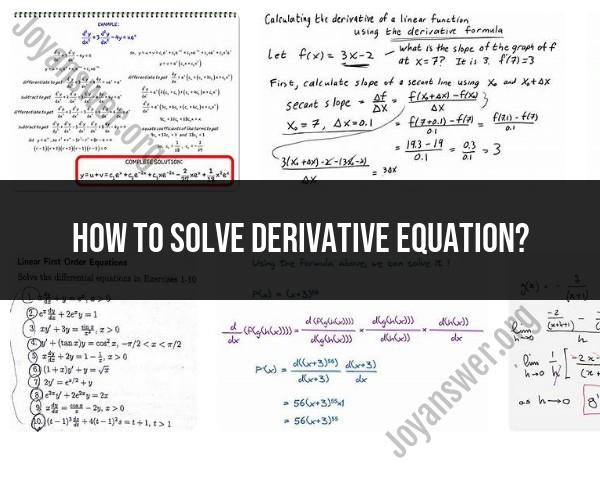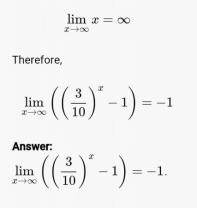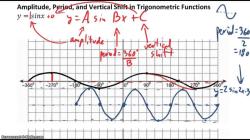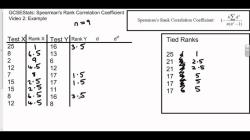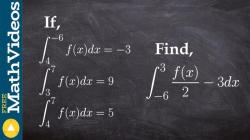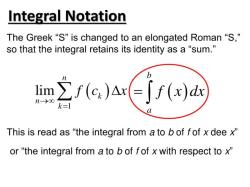How to solve derivative equation?
Solving derivative equations involves finding the unknown function or functions that satisfy a given differential equation involving derivatives. The approach to solving such equations depends on the type of differential equation and its order. Here are some common mathematical techniques for solving derivative equations:
Separation of Variables:
- This technique is often used for first-order ordinary differential equations (ODEs).
- Rearrange the equation to separate the variables, typically by moving all terms involving the derivative to one side and terms without the derivative to the other side.
- Integrate both sides of the equation to find the solution.
Integration:
- For first-order ODEs, you can often solve them by directly integrating both sides.
- For example, if you have an equation of the form dy/dx = f(x), you can integrate both sides to find the solution: ∫dy = ∫f(x) dx.
Exact Differential Equations:
- Some ODEs can be made exact by multiplying by an integrating factor. If the equation becomes exact, you can find a potential function and then the solution.
Linear Differential Equations:
- Linear ODEs have the form a(x)y' + b(x)y = c(x). They can be solved using integrating factors or by rearranging the equation and solving a first-order linear ODE.
Homogeneous Differential Equations:
- Homogeneous ODEs have the form y' = f(x, y), where f(x, y) is a function that is homogeneous of degree 0. You can use substitution methods to transform them into separable equations.
Bernoulli Differential Equations:
- Bernoulli equations have the form y' + P(x)y = Q(x)y^n, where n is a constant. You can use a substitution to transform the equation into a linear ODE.
Substitution:
- Sometimes, a suitable substitution can simplify a differential equation, making it easier to solve.
Power Series:
- Power series methods are used for solving differential equations when the solutions can be represented as power series. This technique is often applied to second-order linear differential equations with variable coefficients.
Laplace Transforms:
- Laplace transforms can be used to solve linear differential equations by transforming them into algebraic equations. This is particularly useful for systems of ODEs or higher-order ODEs.
Numerical Methods:
- When analytical methods fail or are too complex, numerical methods like Euler's method, the Runge-Kutta method, or finite difference methods can be used to approximate solutions.
It's important to recognize that the technique you use depends on the specific form of the differential equation. Not all equations can be solved analytically, and in such cases, numerical methods may be necessary. Additionally, boundary conditions or initial conditions are often needed to find unique solutions to differential equations. It's advisable to practice and study the specific methods relevant to the type of differential equations you encounter.
Solving Derivative Equations: Techniques and Methods
There are many different techniques and methods for solving derivative equations. Some of the most common methods include:
- Separation of variables: This method is used to solve equations where the variables can be separated on different sides of the equation.
- Exact equations: This method is used to solve equations that are in the form , where and are functions of both and .
- Homogeneous equations: This method is used to solve equations that are in the form .
- Linear equations: This method is used to solve equations that are in the form .
- Bernoulli equations: This method is used to solve equations that are in the form .
In addition to these general methods, there are also a number of specialized methods for solving specific types of derivative equations.
The Role of Derivatives in Mathematical Problem Solving
Derivatives play an important role in mathematical problem solving. They can be used to solve a wide range of problems, including:
- Finding the maximum or minimum value of a function.
- Finding the rate of change of a function.
- Solving differential equations.
- Modeling real-world phenomena.
Derivatives are also used in many different areas of mathematics, including calculus, physics, engineering, and economics.
Calculus Concepts and Derivative Equations Demystified
Calculus is the branch of mathematics that deals with rates of change. Derivatives are one of the most important concepts in calculus.
A derivative is a measure of the rate of change of a function. It is calculated by taking the limit of the difference quotient as the change in the independent variable approaches zero.
Derivative equations are equations that involve derivatives. They can be used to model real-world phenomena such as motion, growth, and decay.
Real-World Applications and Challenges Involving Derivatives
Here are some examples of real-world applications and challenges involving derivatives:
- Motion: Derivatives can be used to model the motion of an object, such as its velocity and acceleration. This information can be used to design vehicles and other machines, and to predict the motion of objects in the natural world.
- Growth and decay: Derivatives can be used to model the growth and decay of populations, and the spread of diseases. This information can be used to develop strategies for managing resources and controlling the spread of disease.
- Economics: Derivatives are used in economics to model the behavior of markets and to predict future prices. This information can be used to make investment decisions and to develop economic policies.
Building Problem-Solving Skills Through Derivative Equations
Solving derivative equations can help you to build problem-solving skills. When you solve a derivative equation, you are learning to:
- Identify the relevant mathematical concepts.
- Apply the appropriate techniques and methods.
- Interpret the results.
Solving derivative equations can also help you to develop your critical thinking skills. You need to be able to think creatively and to come up with new approaches to solving problems.
If you are interested in building your problem-solving skills, I encourage you to learn more about derivative equations and how to solve them. There are many resources available online and in libraries. You can also find helpful tutorials on YouTube.
